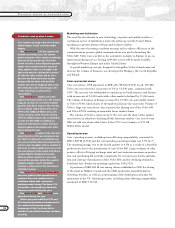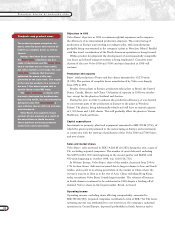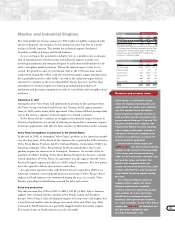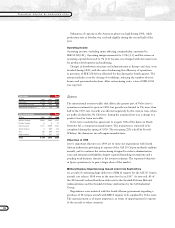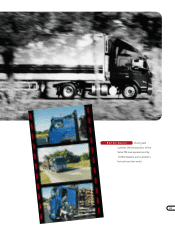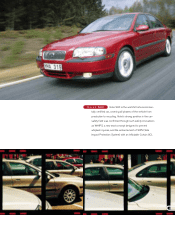Volvo 1998 Annual Report Download - page 37
Download and view the complete annual report
Please find page 37 of the 1998 Volvo annual report below. You can navigate through the pages in the report by either clicking on the pages listed below, or by using the keyword search tool below to find specific information within the annual report.
35
SEK M 1996 1997 1998
Net sales 3,885 4,466 4,931
Operating income1(27) 181 95
Operating margin, %1(0.7) 4.1 1.9
1 Excluding items affecting comparability during 1998.
Including items affecting comparability of SEK 158 M,
operating loss amounted SEK 63 M and operating
margin was (1.3) during 1998.
SEK M 1996 1997 1998
Western Europe 2,048 2,219 2,725
Eastern Europe 2 34 23
North America 1,142 1,332 1,412
South America 109 136 153
Asia 486 643 476
Other countries 98 102 142
Total 3,885 4,466 4,931
Key ratios
Marine/IndustrialNet sales/market
Marine and Industrial Engines
The total market for marine engines in 1998 weakened slightly compared with
the preceding year, due mainly to lower demand in Asia, but also to a small
decline in North America. The market for industrial engines developed
favorably, notably in Europe and North America.
As is occurring in the automotive industry, but on a smaller scale, an integra-
tion of manufacturers of both marine and industrial engines is under way
involving acquisitions and mergers designed to yield increased benefits of scale
and to strengthen market positions. Where the marine engine sector is con-
cerned, the growth in sales of recreational craft in the 1990s has been much
weaker than during the 1980s, with the result that marine engine manufacturers
have gradually turned to other fields. Growth in the industrial engine field is
expected to continue in the years immediately ahead, however, and the large
manufacturers of diesel engines are buying up independent builders of
machinery and generator equipment in order to consolidate and strengthen their
positions.
Objectives in 1999
During the year Volvo Penta will implement its portion of the agreement that
the Volvo Group concluded with Deutz, the German diesel engine manufac-
turer, in 1998; under terms of the agreement Volvo Penta will have an important
role as the Group’s supplier of diesel engines to external customers.
Volvo Penta will also continue to strengthen its industrial engine business in
all areas of application as a means of reducing its dependence on marine engines
for leisure applications craft that are more sensitive to fluctuations in the economy.
Volvo Penta strengthens its positions in the United States
In the end of 1998, to strengthen Volvo Penta’s position in the American market
over the long term, Volvo Penta of the Americas Inc acquired the 40% interest in
Volvo Penta Marine Products held by Outboard Marine Corporation (OMC), an
American company. Volvo Penta Marine Products manufactures drives and
gasoline engines for marine use in Lexington, Tennessee. As a result of the ac-
quisition of OMC’s holding, Volvo Penta Marine Products has become a wholly
owned subsidiary of Volvo Penta. An agreement was also signed whereby Volvo
Penta will supply engines and drives to OMC-owned companies. The two parties
have also agreed to deliver spare parts to each other.
An agreement reached earlier with Detroit Diesel Corporation (DDC), an
American company, covering distribution and servicing of Volvo Penta’s diesel
engines in North America was terminated during the year. As a result, Volvo
Penta is expanding its distribution network for sales and service.
Sales and production
Net sales increased by 10% in 1998, to SEK 4,931 M (4,466). Sales of marine
engines were strong in Europe, notably in the Nordic region and Southern
Europe. Volvo Penta’s sales of industrial engines in Europe were also higher, but
a trend toward smaller order bookings was noted at the end of the year. Sales
increased in North America in a generally sluggish market for marine engines.
The trend of sales in South America was also favorable.
Volvo Penta is a well-known brand
name for engines, transmissions and
applications for marine and industrial
use. The product line in the Marine
Leisure business segment consists of
both gasoline and diesel engines with
power outputs between 10 hp and 770
hp, plus complete drive systems. The
Commercial Marine business segment
offers engines with power outputs of
100 hp to 770 hp and complete drive
systems for propulsion, as well as for
marina auxiliary equipment.
A new marine diesel engine, the
TAMD74 EDC, one of the most powerful
engines in the market in the important
7-liter class, was introduced during
1998. A new fuel system consumes less
fuel and has lower emissions. The
world’s first integrated water-jet
system, the result of Volvo Penta’s joint
venture with Kamewa, was introduced
in the North American market during
the year.
The Industrial Engines business
segment offers engines for many
different applications. Irrigation
systems, generator equipment, propul-
sion systems for trains and heavy
forklift trucks, equipment used in
terminals, and agricultural machines,
are some examples. A new 7-liter diesel
engine, the TAD74GE, for industrial use
and generator equipment, was
presented during the year.
Products and product news
Marine/Industrial





